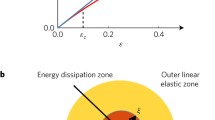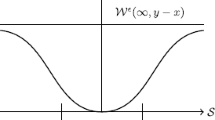Abstract
The equation of motion and the stability conditions of surface cracks which are subjected to stress waves are derived from an energy balance and the law of angular momentum conservation. From the resulting differential equation the terminal crack velocity and dynamic threshold conditions can be derived. It will be shown that not only a critical stress (amplitude of the wave) but also a critical time (duration of the wave) are necessary to move the crack. These two critical quantities can be combined to a critical action. The specific action of the wave must exceed a certain minimal value for crack propagation to occur. Quantum considerations allow us to generalize this criterion further. Some simple applications of the least action law are mentioned. Supercritical stress pulses are also treated briefly. This leads to the concept of the cross section of a stress wave. Crack stability can also be treated as an eigenvalue problem.
Résumé
Les équations de déplacement et les conditions de stabilité relatives à des fissures superficielles sujettes à des trains d'ondes de tension sont tirées d'une analyse de l'équilibre des énergies, et de la loi de conservation des moments angulaires.
On pent déduire de 1'equation différentielle qui en découle la vitesse de propagation de la fissure et les conditions critiques de stabilité.
On montre que, pour faire se mouvoir une fissure, il faut réunir à la fois une contrainte critique (l'amplitude de l'onde) et une durée de temps critique (la durée de l'onde).
Ces deux facteurs critiques combinent leur action de façon critique.
L'effet spécifique de l'onde doit dépasser une certaine valeur minimale pour occasionner la propagation de la fissure. Ce critère peut être généralisé davantage par des considérations quantiques. On inentionne quelques applications simples de la loi de la moindre action. On traite également des impulsions de contrainte supercritiques, et on est conduit à la notion de section droite d'une onde de contrainte.
La stabilité de la fissure pent par ailleurs être également traitée comme un problème “eigenvalue”.
Zusammenfassung
Die Gleichung der Ausbreitungs-und Stabilitätsbedingungen von Oberflächenrissen welche Lastwellen ausgesetzt sind, wird aus dem Gesetz der Erhaltung des Winkelmomentums ermittelt. Aus der sich ergebenden Differentialgleichung können die Rißausbreitungsgeschwindigkeit und die kritischen Stabilitätsbedingungen abgeleitet werden. Es wird gezeigt, daß für die Ausbreitung eines Risses sowohl eine kritische Spannung (Wellenamplitude) als auch eine kritische Dauer (Dauer der Welle) erfordert sind. Diese beiden kritischen Größen können zu einen kritischen Einwirkung verbunden werden.
Die spezifische Einwirkung der Welle muß ein Minimum übersteigen wenn eine Ausbreitung des Risses erfolgen soil. Quantische Überlegungen ermöglichen es diesen Begriff noch weiter zu verallgemeinem. Es werden einige einfache Anwendungen des Gesetzes der geringsten Einwirkung gegeben. Auch überkritische Belastungspulse werden kurz behandelt. Dies führt zum Begriff des Querschnitts einer Lastwelle. Die RiBstabilität kann auch als ein “Eigenwerts”-Problem behandelt werden.
Similar content being viewed by others
References
E. Orowan, Welding J., Res. Suppl. 34 (1955) 157a.
G. R. Irwin, Jour. Appl. Mech., 24 (1957) 361.
J. W. Craggs, Fracture of Solids, Wiley, New York (1 63).
J. J. Gilman, Proc. Inter. Conf Mech. Frac., Wiley, New York (1959).
J. P. Berry, Mech. Phys. Solids, 8 (1960) 194.
B. Steverding and S. H. Lehnigk, Int. J. Fract. Mech., 6 (1970) 223.
B. Steverding and S. H. Lehnigk, J. Appl. Phys., 41 (1970) 2096.
W. F. Osgood, Mechanics, The MacMillan Co., New York (1949).
J. J. Gilman, et al., J. Appl. Phys., 29 (1958) 601.
H. Schardin, Proc. Inter. Con'Atom. Mech. of Frac., John Wiley & Sons, New York (1959).
B. Steverding, Int. J. Fract. Mech. 5 (1969) 243.
B. Steverding, Int. J. Fract. Mech., 6 (1970) 214.
H. Kolsky, Stress Waves in Solids, Clarendon Press, Oxford (1953).
D. A. Shockley, et al., Int. J. Fract. Mech., 5 (1969) 363.
B. Steverding and S. H. Lehnigk, J. Appl. Phys., 42 (1971) 3231.
Author information
Authors and Affiliations
Rights and permissions
About this article
Cite this article
Steverding, B., Lehnigk, S.H. Dynamics of brittle fracture. Int J Fract 8, 59–73 (1972). https://doi.org/10.1007/BF00185198
Received:
Revised:
Issue Date:
DOI: https://doi.org/10.1007/BF00185198




